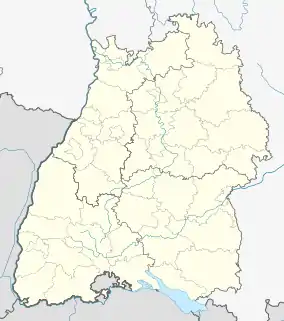Münzesheim
Münzesheim is a part of the town Kraichtal in the district of Karlsruhe in northwestern of Baden-Württemberg, Germany.
Münzesheim | |
|---|---|
Ortsteil of Kraichtal | |
 Coat of arms | |
Location of Münzesheim 
| |
 Münzesheim  Münzesheim | |
| Coordinates: 49°07′19″N 08°42′59″E | |
| Country | Germany |
| State | Baden-Württemberg |
| District | Karlsruhe |
| Town | Kraichtal |
| Area | |
| • Total | 11.81 km2 (4.56 sq mi) |
| Elevation | 177 m (581 ft) |
| Population (2005-12-31) | |
| • Total | 2,737 |
| • Density | 230/km2 (600/sq mi) |
| Time zone | UTC+01:00 (CET) |
| • Summer (DST) | UTC+02:00 (CEST) |
| Postal codes | 76703 |
| Dialling codes | 07250 |
Geography
Münzesheim lies in the hills of the Kraichgau on the flat end of left slope of the Kraichbachvalley. The district area is 11,81 km².
History
828 was first mentioned as Muncinesheim, the place was ruled from 1109 to 1282 by a local aristocracy. In 1326 it became part of Baden, as a fief to the Hofwart family of Kirchheim. The suzerainty probably comes from the Counts of Eberstein and thus of the Kraichgau knights. The fiefdom converted to protestantism in 1530. After reversion of the feud in 1675 Margrave Frederick of Baden gave Münzesheim to his two illegitimate sons, which styled themselves Barons of Münzesheim. Friedrich August of Münzesheim sold the community in 1761 back to the feudal lord, but Baden had to recognize the tax sovereignty of the Kraichgauer knighthood until 1805. From 1805 to 1807 Münzesheim belonged to the District Office Bretten, then to the Town Office Gochsheim. Finally in 1813 temporarily to the city office and the first land office Bruchsal and from December 1813 to the district office Bretten again. 1936 Münzesheim came to the district office Bruchsal.
On 1 September 1971 Gochsheim (Baden) was united with Unteröwisheim and the communities Bahnbrücken, Landshausen, Menzingen (Baden), Münzesheim, Neuenbürg (Baden), Oberacker und Oberöwisheim to the new city of Kraichtal.
In 2005 Münzesheim had 2737 inhabitants.
Crest
The former Crest of Münzesheim shows a red heart in gold topped with a silver ring.
Sights
The Protestant Church of St. Martin's subordinate in the 13th Century the patronage of the Counts of Eberstein; the present church was built new in 1856. The Catholic Church of St. Andrew was built in 1963/65. Among the historic buildings of the town include the Old Forge.
 City Hall Kraichtal
City Hall Kraichtal "Torwächterhaus" Münzesheim
"Torwächterhaus" Münzesheim Old Forge in Münzesheim
Old Forge in Münzesheim Old half-timbered house in Münzesheim
Old half-timbered house in Münzesheim Half-timbered houses in Münzesheim
Half-timbered houses in Münzesheim The river "Kraichbach" in Münzesheim
The river "Kraichbach" in Münzesheim Catholic Church of St. Andrew
Catholic Church of St. Andrew Police station in Kraichtal Münzesheim
Police station in Kraichtal Münzesheim "Sparkasse Kraichgau" - Branch Münzesheim
"Sparkasse Kraichgau" - Branch Münzesheim "Volksbank Bretten" - Branch Münzesheim
"Volksbank Bretten" - Branch Münzesheim School "Markgrafenschule Münzesheim"
School "Markgrafenschule Münzesheim" School "Mönchswegschule Münzesheim"
School "Mönchswegschule Münzesheim" Gymnasium and swimming pool Münzesheim
Gymnasium and swimming pool Münzesheim Roundabout with a view to the old cemetery Münzesheim
Roundabout with a view to the old cemetery Münzesheim Funeral parlor to the new cemetery Münzesheim
Funeral parlor to the new cemetery Münzesheim War memorial at the new cemetery Münzesheim
War memorial at the new cemetery Münzesheim Asiatic garden
Asiatic garden
